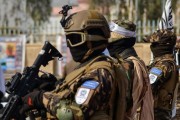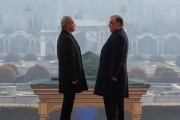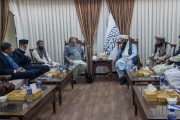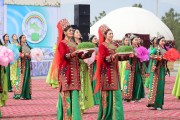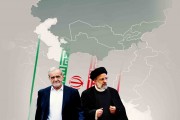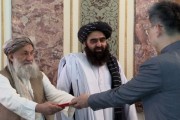Publish Date
Monday 24 May 2021 - 13:41
recommended
0
A Study of Proposed Political Systems in Afghanistan
The US-Taliban talks opened a new way towards the intra-Afghan talks. The talks between the Taliban and the Afghan government have been held for several times in Qatar and Moscow, and will continue in Istanbul in near future. The most important and perhaps the main topic of the Istanbul talks would be the issue of changing Afghanistan's political system. Many Afghan political analysts and politicians believe that the current system needs to be changed. Therefore, they offer different models to be substituted for the presidential system, each of which has its opponents and supporters. This article reviews the proposed political systems in Afghanistan, and then briefly examines each of these systems through a pathological approach.
By: Mohammad Safari
Summary
The Doha Agreement opened a new way towards negotiations between the Afghan government and the Taliban. From the beginning of the intra-Afghan talks in Qatar, speculations about the future of the Afghan political system have increased. The existing groups in Afghanistan have presented different models for the future political system, each of which has its supporters and opponents. The existing models proposed by the political parties and the government are:
Summary
The Doha Agreement opened a new way towards negotiations between the Afghan government and the Taliban. From the beginning of the intra-Afghan talks in Qatar, speculations about the future of the Afghan political system have increased. The existing groups in Afghanistan have presented different models for the future political system, each of which has its supporters and opponents. The existing models proposed by the political parties and the government are:
The presidential system
The parliamentary system
The federal system
The semi-presidential system
The parliamentary system
The federal system
The semi-presidential system
In this study, we will initially explain the four mentioned models, and then we will examine the efficiency or inefficiency of each model via a pathological approach. Finally, a suitable model for the Afghan political system will be proposed.
1- Theoretical foundations:
1-1- The presidential political system
The presidential system, an obvious example of which can be seen in the United States, is a form of political system that is based on the absolute separation of power branches. One of the main features of this form of political system is the existence of an official president who, with considerable legal authority, controls the executive branch and is elected for a certain term by the direct vote of the people, without any parliamentary interference. In this system, the responsibility of the president and ministers in the face of parliament is inconceivable. In this political system, the cabinet ministers are directly elected by the president, and the president has the power to remove them from power. Unlike the parliamentary system, in the presidential system, the executive branch is hierarchical and the ministers are completely dependent on the president. On the other hand, the members of parliament are elected by the people in a separate election for a certain term. In this system, the main principle is equilibrium among the power branches (executive, legislature, and judiciary), and none of them have the ability to dominate over the other. Thus, independence and complete separation of branches is the fundamental feature of this form of government. In this system, there are special ways to curb the president’s possible autocracy or even to exert the parliament’s pressure on other branches.
1-2- The parliamentary system
The parliamentary system was established in Britain and later in Canada, Australia and India. In this form of the government, there is a very close relationship between the executive and legislature branches. In this sense, the parliamentary system is based on the principle of relative separation of power branches, in which the Public Will appears through election, and then it is transferred to different institutions or individuals. In this form of the government, this is the parliament that determines the head of the executive branch. This type of political system is called the responsible form of government because the administration is accountable to the parliament. In this structure, the legislative branch has superiority over the executive branch and only the parliament has the democratic legitimacy. In this type of system, the head of the executive branch is called the prime minister and is elected by the legislature, and the post of the prime minister is subject to the support of a party or coalition of parties. In general, the people indirectly elect the head of the government by voting to their representatives in the parliamentary elections, and finally the members of parliament elect the prime minister. In this form of the government, there are principles to curb the monopoly of the legislature that gives special authority to the head of government.
1-3- The federal system
Although federalism is not a specific type of political system, there are many countries that have a parliamentary system but are governed based on a federal structure, such as India. There are also other countries that have a presidential system, but have a federal structure, such as the United States. Thus, the federal system is more the administrative style of a political system. There are various interpretations and definitions of federalism. The Britanica Encyclopedia defines federalism as “a mode of political organization that unites separate states or other polities within an overarching political system in a way that allows each to maintain its own integrity.” In its simplest definition, it can be said that federalism is a system in which power is divided between the national and local units of government, and the local units can operate independently within their legal authority sphere. The local governments can legislate independently, but there are some general and national laws that are under the control of the central government.
1-4- The semi-presidential system
The semi-presidential system is in fact a combination of the parliamentary and presidential systems. In this system, the executive branch has two pillars, meaning that president is elected by the people, but the prime minister is appointed by the parliament. The president also introduces the ministers to the parliament for a vote of confidence. The most obvious example of a semi-presidential system can be seen in the French Fourth Republic. This kind of political system can be described as follows: In a semi-presidential system, the government is accountable to the parliament, and at the same time the government can dissolve the parliament, but the president is directly elected by the people as the head of the executive branch and will not be removed from office by the legislature until the end of his term, except in exceptional cases. In this system, the executive branch is formed by the winning party or a coalition of parties. The executive branch includes the parliament. In this political system, the president is elected by the popular vote for a certain term. He heads both the government and the executive branch. In this system, the prime minister has less power than the president. In this type of political system, the president has no right to dissolve the parliament.
2- Pathology of political systems in Afghanistan
The US-Taliban talks opened a new way towards the intra-Afghan talks. The talks between the Taliban and the Afghan government have been held several times in Qatar and Moscow, and will continue in Istanbul in near future. The most important and perhaps the main issue of the Istanbul talks is the issue of changing Afghanistan's political system. Many Afghan political analysts and politicians believe that the current system needs to be changed. Therefore, they offer different models as substitute for the presidential system, each of which has its opponents and supporters. In this section, we briefly examine each of these political systems in Afghanistan through a pathological approach.
2-1-The presidential system
A significant number of political leaders in Afghanistan believe that the main reason for the continuation of the crisis in the last twenty years lies in the nature of the current political system of Afghanistan, namely the presidential system. These political leaders, such as Ahmad Wali Massoud and Latif Pedram, believe that the presidential system in Afghanistan has led to monopoly and is unable to solve the existing problems. Moreover, the scholars of the political and social sciences also maintain that the current system is not suitable for Afghanistan. Among those who suggest a decentralized model is Nazifaullah Shahrani, a professor at Indiana University in the United States. He believes that the solution to the current crisis is to create a decentralized system. Although he admits to the inefficiencies of the federal system in Afghanistan, he also states that it is necessary for Afghanistan to have a semi-presidential system in which the provinces have sufficient power.
Thomas Barfield is another figure who believes in the inefficiency of the presidential system in Afghanistan. He believes that, except for the time of Amir Abdul Rahman Khan, a centralized system has never been formed in Afghanistan, and that the society and geography of Afghanistan are not able to accept a presidential system, because the ethnic context of Afghanistan is a factor of heterogeneity, and the country’s harsh geography has also made it impossible for a central government to exercise its legitimate power over the entire territory. Another important factor mentioned by Seyyed Askar Mousavi is the issue of the ethnic conflicts. According to him, because the Pashtun people consider power as their legitimate right, they will never be willing to actually share their power in a presidential system. There are other factors behind the inefficiency of the presidential system in Afghanistan that are beyond the scope of this article.
2-2- The parliamentary system
The parliamentary system, like the presidential one, has its own serious supporters and opponents. Many opponents of the parliamentary system, such as Sarwar Danesh, the second vice president of Afghanistan, believe that the parliamentary and federal systems have no place in Afghanistan. In their opinion, the parliamentary system needs some factors that do not exist in Afghanistan, such as the existence of powerful political parties. The opponents argue that since the parliamentary system violates the independence of the branches, it can destabilize the societies that are similar to the Afghan society, which is ethnically like a colorful mosaic, and may even lead to the country's disintegration. Another criticism regarding the parliamentary system is about the execution of the political affairs. The opponents of this system believe that in this structure, the policies are always changing and at the external level, even national interests may be violated. The critics also claim that this system can create a vast bureaucracy in the countries like Afghanistan that need immediate decisions. The opponents also maintain that since the power in a parliamentary system is limited to the politicians, it gives more freedom to the ethnic leaders to gain more privilege.
2-3- The federal system
The establishment of a federal system has many opponents in Afghanistan. Many of these opponents, who are in favor of a presidential system, are sharply critical of the structure of the federal system. They believe that, due to the lack of proper political awareness among the people, a federal system will only increase the internal crisis. They also argue that if a federal system is established in Afghanistan, in the long term, it will allow the neighboring and regional countries to intervene in Afghanistan for their interests. On the other hand, creation of such a system in Afghanistan – a country which always needs the help of the international community - will be very costly, because this system will lead to more bureaucracy. And financing this extensive bureaucracy requires huge sources of income. The main concern of the opponents regarding federalism lies in its separatist nature. Many of these critics believe that due to the lack of a strong national structure in Afghanistan, the separatist nature of the federal system can lead to more social division among the ethnic groups and ultimately the disintegration of the country. These four factors are the most important reasons for opposition to federalism in Afghanistan.
2-4- The semi-presidential system
The semi-presidential system which in fact is a combination of the parliamentary and presidential systems, could find supporters in the recent years. The opponents of this system cite the same reasons they have mentioned for their opposition against the parliamentary and presidential systems. For example, the semi-presidential system needs active participation of the political parties, but the structure of the political parties in Afghanistan is very weak. Moreover, the political parties in Afghanistan are more a manifestation of the ethnic will rather than a national-popular will. Some experts critical of the semi-presidential system believe that this system may lead to a kind of confrontation between the government and parliament. They also maintain that creation of this type of political system would leave the power in the hands of the president and is not significantly different from the presidential system. The main criticism of the opponents is that the nature of the current system in Afghanistan is semi-presidential, and this system has not been able to address the political crisis in the country.
3- An efficient political system for Afghanistan
In this article, first the political systems were explained and then, with a pathological approach, each of these systems were briefly examined. In this section, we want to provide a model for the political system that is appropriate for the cultural, historical, geographical and political condition of Afghanistan.
The author maintains that although the political system of Afghanistan is called presidential, the main nature of the current system is very close to the semi-presidential system. The creation of a decentralized semi-presidential system, which arguably could be a semi-federal system, is a viable alternative to the current political system and a good solution for the political crisis in Afghanistan. If we look at the history of modern Afghanistan, we will find that during this era, the central government never dominated its surroundings, except for the era of Amir Abdul Rahman who seized the power by force and killing of innocent people. Even in the decades that there was a calm political and security atmosphere in the country, the legitimate sphere of the government’s influence did not extend beyond the metropolises, and the government's executive actions were limited to the cities. Professor Barfield believes that no central government has been able to reform the central institutions throughout Afghanistan. He believes that Afghanistan culturally, historically, economically and politically needs a decentralized system. Many are worried about disintegration of Afghanistan in the wake of the establishment of a decentralized system, but the history of the civil wars has shown that the ethnic groups, despite their differences, have never pursued separatism.
On the other hand, the ethnic context of Afghanistan is such that ethnicities accuse each other of abusing the power, and this will perpetuate the cycle of the political inefficiencies and ethnic accusations in a presidential or parliamentary system. Thus, creation of a decentralized system can put an end to these differences. In the semi-presidential system, the election of the president, parliamentarians, mayors and governors all take place at the national and local level, which will increase the political participation of the people and create a sense of responsibility among them to determine their political destiny.
In an article entitled “Afghanistan’s Alternatives for Peace, Governance and Development,” Professor Nazif Shahrani analyzes the shortcomings of the Afghan political system and calls a decentralized government based on the autonomy of societies as the best option for this country. At the same time, he rejects the Pashtuns’ hegemonic approach, arguing that different provinces should be given autonomy throughout the country. The local people should be allowed to elect their own political leaders, and based on the principle of meritocracy, appoint the executive officials (in the military, judicial, security and training sectors) within the framework of national law. Professor Barfield also believes that if decentralization of power can create a balance in governance at the national and local levels, it not only does not lead to disintegration of Afghanistan, but also would act as a barrier in the face of such events.
Conclusion
Determining the future political system of Afghanistan will be the most important issue in the Istanbul peace talks between the Afghan government and the Taliban. The leaders of Afghanistan's political and ethnic parties believe in different models for Afghanistan's future, arguing that their prescribed medicine can heal Afghanistan's wounds. The proposed models (presidential, parliamentary, federal and semi-presidential political systems) have their own strengths and weaknesses, which were mentioned above. If examined properly, we will find that Afghanistan has always needed a decentralized system throughout its history, and that Afghanistan's cultural diversity would never allow a single culture to dominate over other cultures. Therefore, among the decentralized systems, the semi-presidential system can be chosen for the future of Afghanistan. And between the federal and semi-presidential models (both of which emphasize decentralization) the semi-presidential system takes precedence because the federal system needs a series of prerequisites that are not available in Afghanistan.
Finally, it can be said that the semi-presidential system is the closest political model that is in line with the current situation of Afghanistan.
Mohammad Safari; is a Master student of political science
1- Theoretical foundations:
1-1- The presidential political system
The presidential system, an obvious example of which can be seen in the United States, is a form of political system that is based on the absolute separation of power branches. One of the main features of this form of political system is the existence of an official president who, with considerable legal authority, controls the executive branch and is elected for a certain term by the direct vote of the people, without any parliamentary interference. In this system, the responsibility of the president and ministers in the face of parliament is inconceivable. In this political system, the cabinet ministers are directly elected by the president, and the president has the power to remove them from power. Unlike the parliamentary system, in the presidential system, the executive branch is hierarchical and the ministers are completely dependent on the president. On the other hand, the members of parliament are elected by the people in a separate election for a certain term. In this system, the main principle is equilibrium among the power branches (executive, legislature, and judiciary), and none of them have the ability to dominate over the other. Thus, independence and complete separation of branches is the fundamental feature of this form of government. In this system, there are special ways to curb the president’s possible autocracy or even to exert the parliament’s pressure on other branches.
1-2- The parliamentary system
The parliamentary system was established in Britain and later in Canada, Australia and India. In this form of the government, there is a very close relationship between the executive and legislature branches. In this sense, the parliamentary system is based on the principle of relative separation of power branches, in which the Public Will appears through election, and then it is transferred to different institutions or individuals. In this form of the government, this is the parliament that determines the head of the executive branch. This type of political system is called the responsible form of government because the administration is accountable to the parliament. In this structure, the legislative branch has superiority over the executive branch and only the parliament has the democratic legitimacy. In this type of system, the head of the executive branch is called the prime minister and is elected by the legislature, and the post of the prime minister is subject to the support of a party or coalition of parties. In general, the people indirectly elect the head of the government by voting to their representatives in the parliamentary elections, and finally the members of parliament elect the prime minister. In this form of the government, there are principles to curb the monopoly of the legislature that gives special authority to the head of government.
1-3- The federal system
Although federalism is not a specific type of political system, there are many countries that have a parliamentary system but are governed based on a federal structure, such as India. There are also other countries that have a presidential system, but have a federal structure, such as the United States. Thus, the federal system is more the administrative style of a political system. There are various interpretations and definitions of federalism. The Britanica Encyclopedia defines federalism as “a mode of political organization that unites separate states or other polities within an overarching political system in a way that allows each to maintain its own integrity.” In its simplest definition, it can be said that federalism is a system in which power is divided between the national and local units of government, and the local units can operate independently within their legal authority sphere. The local governments can legislate independently, but there are some general and national laws that are under the control of the central government.
1-4- The semi-presidential system
The semi-presidential system is in fact a combination of the parliamentary and presidential systems. In this system, the executive branch has two pillars, meaning that president is elected by the people, but the prime minister is appointed by the parliament. The president also introduces the ministers to the parliament for a vote of confidence. The most obvious example of a semi-presidential system can be seen in the French Fourth Republic. This kind of political system can be described as follows: In a semi-presidential system, the government is accountable to the parliament, and at the same time the government can dissolve the parliament, but the president is directly elected by the people as the head of the executive branch and will not be removed from office by the legislature until the end of his term, except in exceptional cases. In this system, the executive branch is formed by the winning party or a coalition of parties. The executive branch includes the parliament. In this political system, the president is elected by the popular vote for a certain term. He heads both the government and the executive branch. In this system, the prime minister has less power than the president. In this type of political system, the president has no right to dissolve the parliament.
2- Pathology of political systems in Afghanistan
The US-Taliban talks opened a new way towards the intra-Afghan talks. The talks between the Taliban and the Afghan government have been held several times in Qatar and Moscow, and will continue in Istanbul in near future. The most important and perhaps the main issue of the Istanbul talks is the issue of changing Afghanistan's political system. Many Afghan political analysts and politicians believe that the current system needs to be changed. Therefore, they offer different models as substitute for the presidential system, each of which has its opponents and supporters. In this section, we briefly examine each of these political systems in Afghanistan through a pathological approach.
2-1-The presidential system
A significant number of political leaders in Afghanistan believe that the main reason for the continuation of the crisis in the last twenty years lies in the nature of the current political system of Afghanistan, namely the presidential system. These political leaders, such as Ahmad Wali Massoud and Latif Pedram, believe that the presidential system in Afghanistan has led to monopoly and is unable to solve the existing problems. Moreover, the scholars of the political and social sciences also maintain that the current system is not suitable for Afghanistan. Among those who suggest a decentralized model is Nazifaullah Shahrani, a professor at Indiana University in the United States. He believes that the solution to the current crisis is to create a decentralized system. Although he admits to the inefficiencies of the federal system in Afghanistan, he also states that it is necessary for Afghanistan to have a semi-presidential system in which the provinces have sufficient power.
Thomas Barfield is another figure who believes in the inefficiency of the presidential system in Afghanistan. He believes that, except for the time of Amir Abdul Rahman Khan, a centralized system has never been formed in Afghanistan, and that the society and geography of Afghanistan are not able to accept a presidential system, because the ethnic context of Afghanistan is a factor of heterogeneity, and the country’s harsh geography has also made it impossible for a central government to exercise its legitimate power over the entire territory. Another important factor mentioned by Seyyed Askar Mousavi is the issue of the ethnic conflicts. According to him, because the Pashtun people consider power as their legitimate right, they will never be willing to actually share their power in a presidential system. There are other factors behind the inefficiency of the presidential system in Afghanistan that are beyond the scope of this article.
2-2- The parliamentary system
The parliamentary system, like the presidential one, has its own serious supporters and opponents. Many opponents of the parliamentary system, such as Sarwar Danesh, the second vice president of Afghanistan, believe that the parliamentary and federal systems have no place in Afghanistan. In their opinion, the parliamentary system needs some factors that do not exist in Afghanistan, such as the existence of powerful political parties. The opponents argue that since the parliamentary system violates the independence of the branches, it can destabilize the societies that are similar to the Afghan society, which is ethnically like a colorful mosaic, and may even lead to the country's disintegration. Another criticism regarding the parliamentary system is about the execution of the political affairs. The opponents of this system believe that in this structure, the policies are always changing and at the external level, even national interests may be violated. The critics also claim that this system can create a vast bureaucracy in the countries like Afghanistan that need immediate decisions. The opponents also maintain that since the power in a parliamentary system is limited to the politicians, it gives more freedom to the ethnic leaders to gain more privilege.
2-3- The federal system
The establishment of a federal system has many opponents in Afghanistan. Many of these opponents, who are in favor of a presidential system, are sharply critical of the structure of the federal system. They believe that, due to the lack of proper political awareness among the people, a federal system will only increase the internal crisis. They also argue that if a federal system is established in Afghanistan, in the long term, it will allow the neighboring and regional countries to intervene in Afghanistan for their interests. On the other hand, creation of such a system in Afghanistan – a country which always needs the help of the international community - will be very costly, because this system will lead to more bureaucracy. And financing this extensive bureaucracy requires huge sources of income. The main concern of the opponents regarding federalism lies in its separatist nature. Many of these critics believe that due to the lack of a strong national structure in Afghanistan, the separatist nature of the federal system can lead to more social division among the ethnic groups and ultimately the disintegration of the country. These four factors are the most important reasons for opposition to federalism in Afghanistan.
2-4- The semi-presidential system
The semi-presidential system which in fact is a combination of the parliamentary and presidential systems, could find supporters in the recent years. The opponents of this system cite the same reasons they have mentioned for their opposition against the parliamentary and presidential systems. For example, the semi-presidential system needs active participation of the political parties, but the structure of the political parties in Afghanistan is very weak. Moreover, the political parties in Afghanistan are more a manifestation of the ethnic will rather than a national-popular will. Some experts critical of the semi-presidential system believe that this system may lead to a kind of confrontation between the government and parliament. They also maintain that creation of this type of political system would leave the power in the hands of the president and is not significantly different from the presidential system. The main criticism of the opponents is that the nature of the current system in Afghanistan is semi-presidential, and this system has not been able to address the political crisis in the country.
3- An efficient political system for Afghanistan
In this article, first the political systems were explained and then, with a pathological approach, each of these systems were briefly examined. In this section, we want to provide a model for the political system that is appropriate for the cultural, historical, geographical and political condition of Afghanistan.
The author maintains that although the political system of Afghanistan is called presidential, the main nature of the current system is very close to the semi-presidential system. The creation of a decentralized semi-presidential system, which arguably could be a semi-federal system, is a viable alternative to the current political system and a good solution for the political crisis in Afghanistan. If we look at the history of modern Afghanistan, we will find that during this era, the central government never dominated its surroundings, except for the era of Amir Abdul Rahman who seized the power by force and killing of innocent people. Even in the decades that there was a calm political and security atmosphere in the country, the legitimate sphere of the government’s influence did not extend beyond the metropolises, and the government's executive actions were limited to the cities. Professor Barfield believes that no central government has been able to reform the central institutions throughout Afghanistan. He believes that Afghanistan culturally, historically, economically and politically needs a decentralized system. Many are worried about disintegration of Afghanistan in the wake of the establishment of a decentralized system, but the history of the civil wars has shown that the ethnic groups, despite their differences, have never pursued separatism.
On the other hand, the ethnic context of Afghanistan is such that ethnicities accuse each other of abusing the power, and this will perpetuate the cycle of the political inefficiencies and ethnic accusations in a presidential or parliamentary system. Thus, creation of a decentralized system can put an end to these differences. In the semi-presidential system, the election of the president, parliamentarians, mayors and governors all take place at the national and local level, which will increase the political participation of the people and create a sense of responsibility among them to determine their political destiny.
In an article entitled “Afghanistan’s Alternatives for Peace, Governance and Development,” Professor Nazif Shahrani analyzes the shortcomings of the Afghan political system and calls a decentralized government based on the autonomy of societies as the best option for this country. At the same time, he rejects the Pashtuns’ hegemonic approach, arguing that different provinces should be given autonomy throughout the country. The local people should be allowed to elect their own political leaders, and based on the principle of meritocracy, appoint the executive officials (in the military, judicial, security and training sectors) within the framework of national law. Professor Barfield also believes that if decentralization of power can create a balance in governance at the national and local levels, it not only does not lead to disintegration of Afghanistan, but also would act as a barrier in the face of such events.
Conclusion
Determining the future political system of Afghanistan will be the most important issue in the Istanbul peace talks between the Afghan government and the Taliban. The leaders of Afghanistan's political and ethnic parties believe in different models for Afghanistan's future, arguing that their prescribed medicine can heal Afghanistan's wounds. The proposed models (presidential, parliamentary, federal and semi-presidential political systems) have their own strengths and weaknesses, which were mentioned above. If examined properly, we will find that Afghanistan has always needed a decentralized system throughout its history, and that Afghanistan's cultural diversity would never allow a single culture to dominate over other cultures. Therefore, among the decentralized systems, the semi-presidential system can be chosen for the future of Afghanistan. And between the federal and semi-presidential models (both of which emphasize decentralization) the semi-presidential system takes precedence because the federal system needs a series of prerequisites that are not available in Afghanistan.
Finally, it can be said that the semi-presidential system is the closest political model that is in line with the current situation of Afghanistan.
Mohammad Safari; is a Master student of political science
News code:2650





